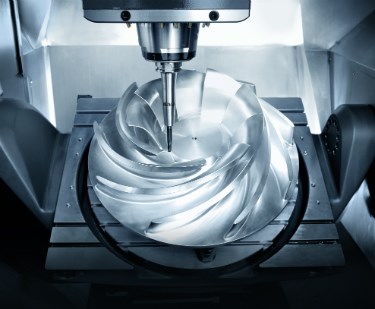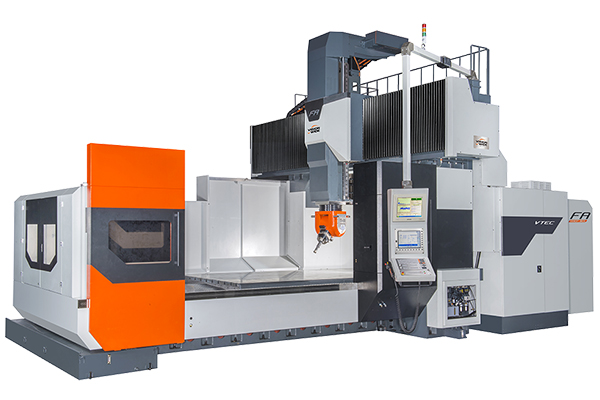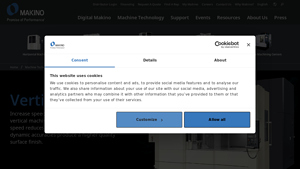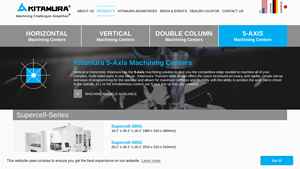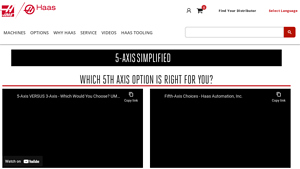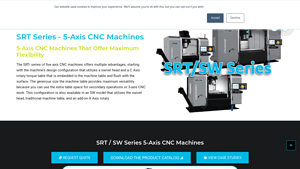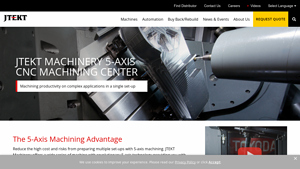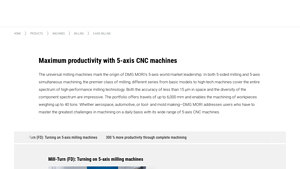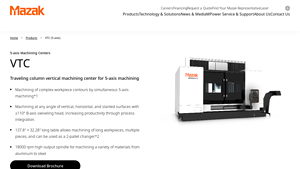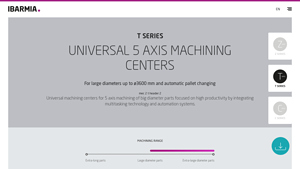5 Axis Machining Centers Guide: Type, Cost, Top List…
Introduction: Navigating the Global Market for 5 axis machining centers
In an increasingly competitive global market, sourcing reliable 5-axis machining centers can be a daunting challenge for international B2B buyers. As manufacturing processes become more complex, the demand for precision and efficiency drives the need for advanced machining solutions that can handle intricate designs with ease. This guide serves as a comprehensive resource, offering insights into various types of 5-axis machining centers, their applications across industries, and essential considerations for supplier vetting and cost analysis.
Buyers from regions such as Africa, South America, the Middle East, and Europe—including countries like Nigeria and Saudi Arabia—will find valuable information tailored to their unique market conditions and operational needs. The guide delves into the distinctions between vertical and horizontal machining centers, outlines the latest technological advancements, and provides practical tips for optimizing production capabilities.
By leveraging this guide, B2B buyers will be empowered to make informed purchasing decisions that enhance operational efficiency and drive profitability. With a thorough understanding of the global landscape for 5-axis machining centers, businesses can strategically position themselves to meet the evolving demands of their respective industries, ensuring they remain competitive in a fast-paced marketplace.
Understanding 5 axis machining centers Types and Variations
| Type Name | Key Distinguishing Features | Primary B2B Applications | Brief Pros & Cons for Buyers |
|---|---|---|---|
| Vertical 5-Axis Machining | Features a vertical spindle orientation; compact design. | Aerospace, medical, and automotive parts. | Pros: Space-efficient; high precision. Cons: Limited to certain workpiece sizes. |
| Horizontal 5-Axis Machining | Horizontal spindle allows for better chip removal and cooling. | Heavy-duty machining, mold making. | Pros: Better for larger, heavier workpieces. Cons: Requires more floor space. |
| Trunnion 5-Axis Machining | Utilizes a trunnion table for enhanced rigidity and flexibility. | Complex geometries in various industries. | Pros: Improved accuracy; versatile setup. Cons: Higher initial investment. |
| Mill-Turn 5-Axis Machining | Combines milling and turning capabilities in one machine. | Aerospace, automotive, and precision tooling. | Pros: Reduces setup time; multi-process efficiency. Cons: Complexity may require skilled operators. |
| Double Column 5-Axis Machining | Large work area with dual columns for stability. | Large component manufacturing. | Pros: High stability for heavy parts. Cons: High cost and large footprint. |
What are the Characteristics and Applications of Vertical 5-Axis Machining Centers?
Vertical 5-axis machining centers feature a vertical spindle, which allows for a compact design and efficient use of space. They are particularly well-suited for industries such as aerospace and medical device manufacturing, where precision and tight tolerances are crucial. Buyers should consider factors like tool accessibility and the specific size of components being machined, as these machines are typically limited to smaller workpieces.
How Do Horizontal 5-Axis Machining Centers Differ from Vertical Ones?
Horizontal 5-axis machining centers are designed with a horizontal spindle orientation, facilitating better chip removal and cooling during operations. This configuration is ideal for heavy-duty machining applications, including mold making and large component manufacturing. Buyers should weigh the benefits of enhanced productivity against the need for additional floor space and potential higher costs associated with maintenance and setup.
What Advantages Do Trunnion 5-Axis Machining Centers Offer?
Trunnion 5-axis machining centers feature a trunnion table design that enhances rigidity and flexibility, allowing for the machining of complex geometries in a single setup. This type of machine is suitable for a wide range of industries, including aerospace and automotive. While they provide significant advantages in terms of accuracy and versatility, buyers must consider the higher initial investment and the complexity of programming and operation.
Why Choose Mill-Turn 5-Axis Machining Centers?
Mill-turn 5-axis machining centers combine milling and turning capabilities, enabling the completion of multiple processes in one machine. This versatility is particularly beneficial for industries that require high precision, such as aerospace and automotive. Buyers should evaluate the potential for reduced setup times and improved workflow against the complexity of operation, which may necessitate skilled operators.
What Makes Double Column 5-Axis Machining Centers a Unique Option?
Double column 5-axis machining centers provide a large work area and enhanced stability, making them ideal for manufacturing large components. They are commonly used in industries that require high precision and can handle heavy workloads. However, the high cost and substantial footprint of these machines may be significant considerations for buyers, particularly in terms of facility layout and overall investment.
Key Industrial Applications of 5 axis machining centers
| Industry/Sector | Specific Application of 5 Axis Machining Centers | Value/Benefit for the Business | Key Sourcing Considerations for this Application |
|---|---|---|---|
| Aerospace | Precision components for aircraft engines and structures | Enhanced accuracy and reduced lead times | Focus on machine rigidity, thermal stability, and precision capabilities. |
| Automotive | Complex parts manufacturing, such as engine blocks and housings | Increased efficiency and reduced setup times | Assess the machine’s ability to handle large workpieces and multiple operations. |
| Medical Devices | Production of intricate surgical instruments and implants | High precision and compliance with stringent regulations | Verify certifications, precision capabilities, and biocompatibility options. |
| Energy | Machining of turbine components for wind and gas turbines | Improved reliability and performance of components | Evaluate the machine’s capacity for heavy-duty machining and material versatility. |
| Tool and Mold Making | Creation of complex molds and tooling for various industries | Reduced production time and enhanced part quality | Consider tooling compatibility, automation options, and cycle time efficiency. |
How Are 5 Axis Machining Centers Used in Aerospace Manufacturing?
In the aerospace industry, 5 axis machining centers are crucial for producing precision components such as turbine blades, structural parts, and engine components. These machines allow manufacturers to achieve high tolerances and complex geometries in a single setup, which reduces the risk of errors and minimizes lead times. Buyers from regions like Europe and the Middle East should prioritize machines with high rigidity and thermal stability to ensure consistent performance during prolonged operations.
What Role Do 5 Axis Machining Centers Play in Automotive Production?
Automotive manufacturers utilize 5 axis machining centers for the production of complex parts, including engine blocks, transmission housings, and intricate components. The ability to machine multiple sides of a workpiece in one setup leads to significant efficiency gains and reduced setup times. B2B buyers in South America and Africa should consider the machine’s capacity for handling large workpieces and its adaptability to various materials, ensuring it meets the demands of modern automotive production.
How Are 5 Axis Machining Centers Enhancing Medical Device Manufacturing?
In the medical device sector, 5 axis machining centers are essential for producing intricate surgical instruments and implants that require high precision and adherence to strict regulatory standards. These machines enable the manufacturing of complex geometries that improve functionality and patient outcomes. Buyers should ensure that the machines are equipped with the necessary certifications and precision capabilities to comply with medical regulations, especially in regions with stringent compliance requirements.
What Benefits Do 5 Axis Machining Centers Provide in Energy Sector Applications?
For the energy sector, particularly in the production of turbine components for wind and gas turbines, 5 axis machining centers offer improved reliability and performance. These machines can efficiently handle large, heavy-duty components while maintaining high precision. B2B buyers should focus on sourcing machines that demonstrate versatility in material handling and can support the rigorous demands of energy production, particularly in emerging markets.
How Are 5 Axis Machining Centers Transforming Tool and Mold Making?
In tool and mold making, 5 axis machining centers facilitate the creation of complex molds and tooling required across various industries. The ability to reduce production time while enhancing part quality makes these machines invaluable. Buyers should evaluate the compatibility of the machining centers with various tooling options, as well as their automation capabilities, to enhance productivity and efficiency in the manufacturing process.
3 Common User Pain Points for ‘5 axis machining centers’ & Their Solutions
Scenario 1: High Setup Costs and Complex Operations
The Problem: Many B2B buyers in the machining industry face significant challenges due to the high upfront costs associated with purchasing 5-axis machining centers. This investment can be daunting, especially for companies in emerging markets like Nigeria or Brazil, where budget constraints are common. Additionally, the complexity of operations can lead to longer training times for staff, which can disrupt production schedules and lead to inefficiencies. Companies may struggle with the justification of ROI, particularly if they are unsure how to fully leverage the capabilities of these advanced machines.
The Solution: To address the high setup costs, buyers should consider financing options or leasing agreements that spread out the investment over time. This makes the acquisition more manageable and allows companies to allocate funds to employee training and support. When sourcing a 5-axis machining center, it’s crucial to work closely with suppliers who offer comprehensive training programs and ongoing support. Look for vendors that provide hands-on training sessions, online resources, and customer service that can assist operators during the learning curve. This investment in training will help maximize the machine’s capabilities and reduce downtime, ultimately leading to a better ROI.
Scenario 2: Difficulty in Achieving Precision and Consistency
The Problem: Achieving the required precision and consistency in machined parts is a common pain point for many manufacturers. Buyers may find that their current 5-axis machining centers are not performing to the expected standards, resulting in increased scrap rates and rework. This issue is particularly pronounced in sectors like aerospace and automotive, where tolerances are tight and quality assurance is critical. Inconsistent results can damage client relationships and impact future contracts, leading to lost revenue.
The Solution: To enhance precision and consistency, buyers should focus on the integration of advanced software solutions that facilitate in-process monitoring and adjustment. When evaluating 5-axis machining centers, prioritize models that come equipped with high-quality feedback systems and real-time monitoring capabilities. Additionally, investing in regular maintenance and calibration services can help ensure that machines are operating at peak performance. Establishing a routine for checking tool wear and maintaining optimal cutting conditions will also contribute to improved consistency in production. Collaborating with suppliers who offer comprehensive support in these areas will lead to enhanced reliability and quality in the finished products.
Scenario 3: Limited Capacity for Complex Geometries
The Problem: As industries evolve, manufacturers are often challenged by the demand for increasingly complex geometries that traditional machining methods struggle to produce. Buyers of 5-axis machining centers may discover that their machines are not equipped to handle the intricacies required for modern components, leading to missed opportunities and potential loss of market share. This limitation can be particularly frustrating for companies looking to enter competitive sectors such as medical device manufacturing or custom automotive parts.
The Solution: To overcome this limitation, buyers should thoroughly evaluate the capabilities of potential 5-axis machining centers, specifically looking for features like high-speed spindle options and advanced toolpath algorithms. It’s beneficial to seek out machines that offer a range of configurations, allowing flexibility in handling various geometries. Additionally, investing in simulation software can help visualize and optimize machining processes before actual production, reducing trial-and-error during machining. Establishing partnerships with technology providers who specialize in complex machining solutions can also provide valuable insights and access to best practices, enabling manufacturers to meet the growing demands for precision and complexity in their products.
Strategic Material Selection Guide for 5 axis machining centers
When selecting materials for 5-axis machining centers, it is essential to consider various factors that can significantly influence performance, durability, and cost-effectiveness. Here, we analyze four common materials used in the construction of components for 5-axis machining centers, focusing on their key properties, advantages, disadvantages, and implications for international B2B buyers.
What Are the Key Properties of Aluminum in 5-Axis Machining?
Aluminum is a lightweight metal known for its excellent machinability and corrosion resistance. It typically exhibits a temperature rating of up to 200°C and is suitable for applications requiring moderate strength. Aluminum is often used in aerospace and automotive components due to its favorable strength-to-weight ratio.
Pros: Aluminum is easy to machine, reducing manufacturing complexity and time. Its lightweight nature also contributes to lower operational energy costs.
Cons: While it offers good strength, aluminum may not withstand high-pressure applications as effectively as other metals. Additionally, its cost can be higher than some alternatives, particularly for high-grade alloys.
Impact on Application: Aluminum is compatible with various media, making it suitable for fluid handling and components exposed to atmospheric conditions.
Considerations for International Buyers: Buyers should ensure compliance with international standards such as ASTM and JIS, particularly when sourcing aluminum alloys. Preferences for specific grades may vary by region, with certain markets favoring higher-strength variants.
How Does Steel Compare as a Material for 5-Axis Machining Centers?
Steel, particularly tool steel, is renowned for its exceptional hardness and tensile strength, making it ideal for high-stress applications. It can withstand temperatures exceeding 300°C and offers good corrosion resistance when properly treated.
Pros: Steel’s durability and strength make it suitable for heavy-duty applications, ensuring longevity and reduced maintenance costs.
Cons: The machining process for steel can be more complex and time-consuming due to its hardness, leading to higher manufacturing costs. Additionally, it is heavier than aluminum, which can impact the dynamics of the machining process.
Impact on Application: Steel components are often used in environments where high wear resistance is required, such as in mold-making and heavy machinery.
Considerations for International Buyers: Buyers must consider the specific grade of steel and ensure compliance with relevant standards such as DIN and ASTM. The availability of specific grades may vary by region, impacting sourcing decisions.
What Are the Benefits of Using Titanium in 5-Axis Machining?
Titanium is a high-performance material known for its exceptional strength-to-weight ratio and corrosion resistance. It can withstand temperatures up to 600°C, making it suitable for aerospace and medical applications.
Pros: Titanium’s strength and lightweight properties make it ideal for applications where performance is critical. Its corrosion resistance also extends the lifespan of components in harsh environments.
Cons: The primary drawback of titanium is its high cost and the complexity involved in machining, which can significantly increase production times and costs.
Impact on Application: Titanium is often used in aerospace components and medical devices, where both strength and biocompatibility are essential.
Considerations for International Buyers: Buyers should be aware of the stringent quality and compliance standards in the aerospace and medical sectors, including ASTM and ISO certifications. The high cost may also limit its use to high-value applications.
Why Is Composite Material an Attractive Option for 5-Axis Machining?
Composite materials, including carbon fiber and fiberglass, offer unique properties such as lightweight construction and high strength. They can withstand considerable stress and are often used in applications requiring specific thermal and electrical properties.
Pros: Composites are lightweight, leading to reduced energy consumption in machining operations. They also provide excellent resistance to corrosion and fatigue.
Cons: The primary challenges with composites include higher costs and the complexity of machining, which may require specialized tools and techniques.
Impact on Application: Composites are increasingly used in aerospace, automotive, and sports equipment, where performance and weight savings are critical.
Considerations for International Buyers: Buyers should ensure that suppliers adhere to international standards for composites, as specifications can vary widely. Understanding local market preferences for composite materials is also crucial.
Summary Table of Material Selection for 5-Axis Machining Centers
| Material | Typical Use Case for 5 axis machining centers | Key Advantage | Key Disadvantage/Limitation | Relative Cost (Low/Med/High) |
|---|---|---|---|---|
| Aluminum | Aerospace components, automotive parts | Lightweight and easy to machine | Limited high-pressure performance | Medium |
| Steel | Heavy machinery, mold-making | Exceptional durability and strength | Complex machining process | Medium |
| Titanium | Aerospace and medical applications | High strength-to-weight ratio | High cost and complex machining | High |
| Composite | Aerospace, automotive, sports equipment | Lightweight and corrosion-resistant | Higher costs and machining complexity | High |
This analysis provides a comprehensive overview of material selection for 5-axis machining centers, highlighting essential properties and considerations for international B2B buyers. Understanding these factors can aid in making informed decisions that align with operational needs and market demands.
In-depth Look: Manufacturing Processes and Quality Assurance for 5 axis machining centers
What Are the Main Stages of Manufacturing 5-Axis Machining Centers?
Manufacturing 5-axis machining centers involves several critical stages, each requiring precision and specialized techniques to ensure the final product meets stringent quality standards. The main stages include material preparation, forming, assembly, and finishing.
How Is Material Prepared for 5-Axis Machining Centers?
The process begins with material selection and preparation. Common materials used in the manufacturing of 5-axis machining centers include high-strength alloys, stainless steels, and composites, chosen based on the machine’s intended application. Material preparation involves cutting, grinding, and sometimes heat treatment to achieve the desired mechanical properties and dimensions. For instance, pre-machining processes may include CNC machining to create rough outlines, ensuring that the subsequent forming processes are efficient and accurate.
What Techniques Are Used in the Forming Stage?
Forming is a pivotal stage where the prepared materials are shaped into the components of the machining center. Techniques such as precision casting, forging, and CNC machining are frequently employed. CNC machining is particularly vital in this stage, as it allows for the intricate geometries required for 5-axis capabilities. The use of advanced tooling and fixtures ensures that tolerances are maintained, which is crucial for the machine’s performance.
How Is Assembly Conducted for 5-Axis Machining Centers?
The assembly stage involves the integration of various components, including the spindle, axis drives, and control systems. This stage requires a high level of expertise, as the alignment and calibration of each component are essential for achieving optimal performance. The assembly process often employs modular construction techniques, allowing for easier upgrades and maintenance in the future. Additionally, the use of digital assembly tools can enhance precision and efficiency during this stage.
What Finishing Processes Are Commonly Used?
Finishing processes are critical for enhancing the surface quality and functional characteristics of the machining centers. Common techniques include anodizing, painting, and surface grinding, which not only improve aesthetics but also protect against wear and corrosion. Quality control during finishing ensures that all surfaces meet the required specifications, contributing to the machine’s longevity and reliability.
What Quality Assurance Measures Are Essential for 5-Axis Machining Centers?
Quality assurance (QA) in the manufacturing of 5-axis machining centers is crucial for ensuring that the final product meets both international and industry-specific standards. Adherence to these standards is vital for international B2B buyers looking for reliable and high-performance machines.
Which International Standards Should Buyers Be Aware Of?
International standards such as ISO 9001 are fundamental to quality management systems and ensure that manufacturers maintain consistent quality in their products and services. Other relevant standards might include CE marking for safety and environmental compliance, as well as industry-specific certifications such as API for oil and gas equipment.
What Are the Key Quality Control Checkpoints in Manufacturing?
Quality control involves multiple checkpoints throughout the manufacturing process:
- Incoming Quality Control (IQC): This involves inspecting raw materials and components upon receipt to ensure they meet specified standards before processing begins.
- In-Process Quality Control (IPQC): Conducted during the manufacturing stages, IPQC monitors critical processes to catch any deviations in real-time, allowing for immediate corrective actions.
- Final Quality Control (FQC): This stage encompasses a comprehensive inspection of the completed machining center, including functional tests, dimensional checks, and performance evaluations.
What Testing Methods Are Commonly Used in Quality Assurance?
Various testing methods are employed to ensure product quality, including non-destructive testing (NDT) techniques, dimensional inspections using coordinate measuring machines (CMM), and performance testing under simulated operational conditions. These methods help identify any potential defects or weaknesses in the final product before it reaches the customer.
How Can B2B Buyers Verify Supplier Quality Control?
For international B2B buyers, particularly those from Africa, South America, the Middle East, and Europe, verifying a supplier’s quality control practices is essential. There are several strategies to ensure suppliers adhere to rigorous QA standards:
What Should Buyers Look for in Supplier Audits?
Conducting supplier audits is a proactive approach to quality assurance. Buyers should review audit reports that detail the supplier’s adherence to quality management systems and international standards. Key areas to focus on include the supplier’s historical performance, compliance with safety regulations, and evidence of continuous improvement initiatives.
How Can Buyers Utilize Third-Party Inspections?
Engaging third-party inspection services can provide an unbiased evaluation of a supplier’s manufacturing and quality control processes. These inspections can occur at various stages of production, ensuring that the products meet the required specifications before shipment. Buyers should request detailed inspection reports, which can serve as a valuable tool in their decision-making process.
What Are the Quality Control Nuances for International Transactions?
B2B buyers must also consider the nuances of international transactions, such as varying regulatory requirements and certification standards across different regions. It is crucial to communicate clearly with suppliers about these requirements and ensure that they are capable of meeting them. Establishing strong relationships with suppliers who have a proven track record in international markets can mitigate risks and enhance product reliability.
Conclusion
Understanding the manufacturing processes and quality assurance measures for 5-axis machining centers is vital for B2B buyers looking to invest in these sophisticated machines. By focusing on the stages of manufacturing, key quality control checkpoints, and methods for verifying supplier quality, buyers can make informed decisions that align with their operational needs and international standards. This comprehensive approach not only ensures the acquisition of high-quality machinery but also fosters long-term partnerships with reputable suppliers.
Practical Sourcing Guide: A Step-by-Step Checklist for ‘5 axis machining centers’
The procurement of 5-axis machining centers is a critical investment for manufacturers seeking precision and efficiency. This guide provides a structured checklist to help B2B buyers navigate the complexities of sourcing these advanced machines, ensuring that they make informed decisions that align with their operational needs and strategic goals.
1. Identify Your Production Needs
Understanding your specific production requirements is the first step in sourcing a 5-axis machining center. Consider factors such as the types of materials you will be machining, the complexity of the parts, and the expected production volume. This clarity will guide you in selecting a machine that meets your operational demands.
- Material Types: Ensure the machine can handle the materials you typically work with, whether metals, plastics, or composites.
- Complexity and Size: Assess the size and intricacy of components to choose an appropriate machine size and capability.
2. Define Your Technical Specifications
Once you have a grasp of your production needs, outline the technical specifications required for your machining center. This includes travel distances, spindle speeds, and tooling options.
- Travel Distances: Ensure the machine can accommodate the size of the workpieces you will be manufacturing.
- Spindle Speed and Power: Higher spindle speeds can enhance productivity but may also require more robust machine structures.
3. Evaluate Potential Suppliers
Before committing to a purchase, it’s crucial to vet suppliers thoroughly. Request company profiles, case studies, and references from buyers in a similar industry or region.
- Supplier Reputation: Investigate their market presence and customer feedback to gauge reliability and service quality.
- After-Sales Support: Look for suppliers who offer comprehensive maintenance and support services, as these can significantly impact machine longevity and performance.
4. Request Demonstrations and Trials
If possible, arrange for demonstrations or trials of the machines you are considering. This hands-on experience is invaluable for assessing performance and ease of use.
- Machine Features: Observe the machine’s capabilities in real-time to ensure it meets your expectations for speed and precision.
- User Interface: Evaluate the control systems and software to ensure they are intuitive and align with your operators’ skill levels.
5. Review Total Cost of Ownership (TCO)
When evaluating options, go beyond the initial purchase price and consider the total cost of ownership. This includes maintenance, tooling, energy consumption, and potential downtime.
- Maintenance Costs: Investigate the frequency and cost of required maintenance to avoid unexpected expenses.
- Energy Efficiency: Machines that consume less energy can lead to significant savings over time, especially in high-volume production.
6. Assess Financing Options
Explore financing options that may be available through suppliers or third-party lenders. Understand the terms and conditions to ensure they fit within your budgetary constraints.
- Lease vs. Purchase: Weigh the benefits of leasing against purchasing outright, considering your cash flow and long-term operational goals.
- Incentives and Grants: Check for any government incentives or grants for purchasing advanced manufacturing equipment, which can ease financial burdens.
7. Finalize and Negotiate Terms
Once you have selected a supplier, finalize the purchase agreement. Pay close attention to the terms of delivery, warranty, and service agreements.
- Delivery Timeline: Ensure that the timeline for delivery aligns with your production schedule.
- Warranty Coverage: Understand the warranty terms and conditions to protect your investment against potential defects or failures.
By following these steps, B2B buyers can make well-informed decisions when sourcing 5-axis machining centers, ensuring that they choose the right equipment to enhance their manufacturing capabilities.
Comprehensive Cost and Pricing Analysis for 5 axis machining centers Sourcing
What Are the Key Cost Components in Sourcing 5-Axis Machining Centers?
When sourcing 5-axis machining centers, understanding the cost structure is essential for international B2B buyers. The primary cost components include:
-
Materials: The quality and type of materials used in the construction of the machining centers significantly impact costs. High-grade steel and advanced alloys for structural integrity and precision machining lead to higher material costs, but they ensure durability and performance.
-
Labor: Labor costs vary based on the region of manufacturing. Countries with skilled labor may have higher wages, but they often compensate with enhanced craftsmanship and lower defect rates.
-
Manufacturing Overhead: This includes utilities, facility costs, and administrative expenses. Suppliers with advanced manufacturing technologies may have lower overhead costs due to automation, which can be passed on to buyers.
-
Tooling: Specialized tools are necessary for 5-axis machining, influencing both the initial purchase price and ongoing operational costs. Custom tooling can lead to increased costs but may be necessary for specific applications.
-
Quality Control (QC): Rigorous QC processes ensure that machining centers meet specified tolerances and performance standards. This adds to the overall cost but is crucial for maintaining quality in production.
-
Logistics: Transporting large machinery involves significant logistics costs, especially for international shipments. Factors such as distance, shipping method, and local regulations can all influence these expenses.
-
Margin: Suppliers typically include a margin in their pricing to ensure profitability. This margin can vary based on market demand, competition, and the supplier’s brand reputation.
How Do Price Influencers Affect the Cost of 5-Axis Machining Centers?
Several factors can influence the pricing of 5-axis machining centers:
-
Volume/MOQ: Larger orders often lead to discounts due to economies of scale. Buyers should consider negotiating minimum order quantities (MOQs) for better pricing.
-
Specifications and Customization: Customized features or specifications can lead to higher costs. Buyers should clearly define their requirements to avoid unexpected expenses.
-
Materials Used: The choice of materials can significantly affect pricing. Premium materials may enhance performance but also increase costs.
-
Quality and Certifications: Machines that meet international standards or come with certifications (e.g., ISO, CE) may have higher price points due to the assurance of quality.
-
Supplier Factors: The supplier’s reputation, experience, and service offerings can influence pricing. Established brands may command higher prices due to trust and reliability.
-
Incoterms: Understanding Incoterms is crucial for international buyers. Terms like FOB (Free on Board) or CIF (Cost, Insurance, and Freight) can impact the total landed cost of the machinery.
What Tips Can Help Buyers Optimize Costs for 5-Axis Machining Centers?
For international buyers, especially those in Africa, South America, the Middle East, and Europe, here are actionable tips to optimize costs:
-
Negotiation Strategies: Engage in negotiations with suppliers to explore pricing flexibility, especially for bulk orders. Use competitive quotes from different suppliers to leverage better pricing.
-
Focus on Cost-Efficiency: Evaluate the Total Cost of Ownership (TCO), which includes not only the initial purchase price but also maintenance, operational efficiency, and downtime costs.
-
Understand Pricing Nuances: Prices can vary widely based on geographical location, currency fluctuations, and local market conditions. Buyers should be aware of these factors when making purchasing decisions.
-
Seek Local Suppliers: Whenever possible, consider sourcing from local suppliers to reduce logistics costs and lead times. Local suppliers may also offer better after-sales support.
-
Request Detailed Quotes: Always request a comprehensive quote that breaks down costs into components. This transparency helps in understanding where savings can be made.
Disclaimer on Indicative Prices
Prices for 5-axis machining centers can fluctuate based on market conditions, supplier pricing strategies, and material costs. Buyers are advised to seek updated quotes and conduct thorough market research to obtain the most accurate pricing information.
Alternatives Analysis: Comparing 5 axis machining centers With Other Solutions
Understanding Alternatives to 5 Axis Machining Centers
When evaluating manufacturing solutions, it’s essential to consider alternatives to 5 axis machining centers. These alternatives can provide unique benefits depending on specific application requirements, production volumes, and budget constraints. This analysis focuses on comparing 5 axis machining centers with two viable alternatives: traditional 3 axis machining centers and multi-tasking machines (mill-turn centers).
| Comparison Aspect | 5 Axis Machining Centers | Traditional 3 Axis Machining Centers | Multi-Tasking Machines (Mill-Turn Centers) |
|---|---|---|---|
| Performance | High precision and complex geometries; suitable for intricate parts | Limited to simpler geometries; less efficient for complex parts | Capable of both milling and turning; versatile in operations |
| Cost | Generally higher upfront investment; long-term savings due to reduced setups | Lower initial cost; higher operational costs due to longer cycle times | Higher initial investment; cost-effective for complex parts due to reduced setups |
| Ease of Implementation | Requires skilled operators; more complex programming | Easier to operate with simpler programming | Moderate complexity; requires training for effective use |
| Maintenance | Regular calibration and part replacements needed; sophisticated maintenance required | Lower maintenance needs; simpler mechanical systems | More complex maintenance due to integrated systems |
| Best Use Case | Aerospace, automotive, and medical industries requiring high precision | General machining tasks, prototypes, and low-volume production | Complex parts requiring multiple operations in one setup |
What Are the Pros and Cons of Traditional 3 Axis Machining Centers?
Traditional 3 axis machining centers are widely used due to their straightforward operation and lower costs. They are ideal for simpler machining tasks, where the geometry of parts does not require the advanced capabilities of 5 axis machines. However, while they are less expensive and easier to maintain, they often involve multiple setups for complex parts, which can lead to inefficiencies and longer lead times. This makes them less suitable for industries where precision and rapid production are critical.
How Do Multi-Tasking Machines (Mill-Turn Centers) Compare?
Multi-tasking machines, or mill-turn centers, combine milling and turning capabilities into one machine. This versatility allows manufacturers to perform multiple operations on a single setup, significantly reducing production time and increasing efficiency for complex components. Although they require a higher initial investment and more training for operators, their ability to handle complex geometries and various materials makes them a valuable alternative to 5 axis machining centers. They are particularly advantageous in industries like aerospace and automotive, where component complexity is high.
How Can B2B Buyers Choose the Right Solution for Their Needs?
When selecting between 5 axis machining centers and alternative solutions, B2B buyers should consider their specific manufacturing needs, including part complexity, production volume, and budget. For businesses producing highly intricate components where precision is paramount, 5 axis machining centers may be the best option despite the higher initial investment. Conversely, if the focus is on simpler parts or lower volume production, traditional 3 axis machines might suffice. For those requiring versatility and efficiency in machining processes, mill-turn centers offer an attractive middle ground. Ultimately, understanding the unique requirements of their operations will guide buyers in choosing the most suitable technology.
Essential Technical Properties and Trade Terminology for 5 axis machining centers
What are the Key Technical Properties of 5 Axis Machining Centers?
Understanding the essential technical properties of 5-axis machining centers is vital for B2B buyers looking to invest in advanced manufacturing technology. Here are critical specifications to consider:
-
Travel Range
The travel range refers to the maximum distance the machine’s axes can move. This is typically defined in millimeters (mm) for the X, Y, and Z axes. A larger travel range allows for the machining of bigger workpieces, making it crucial for industries such as aerospace and automotive. For example, machines with travel ranges of up to 6,000 mm can handle larger components, reducing the need for multiple setups. -
Positioning Accuracy and Repeatability
Positioning accuracy is the machine’s ability to reach a specified location, often measured in micrometers (µm). Repeatability refers to the machine’s ability to return to a specific position consistently. High accuracy and repeatability are essential for producing complex parts with tight tolerances, particularly in industries requiring high precision, such as medical device manufacturing. -
Spindle Speed and Power
The spindle speed, measured in revolutions per minute (RPM), indicates how fast the cutting tool can rotate. Higher spindle speeds can improve machining efficiency and surface finish. Additionally, the spindle power, typically expressed in kilowatts (kW) or Newton-meters (Nm), determines how effectively the machine can cut through various materials. Machines with powerful spindles are better suited for challenging materials like titanium or hardened steel. -
Tool Change Time
This specification measures how quickly a machine can switch between different cutting tools. Efficient tool change times reduce downtime and enhance productivity, especially in environments where multiple parts are being machined in a single run. A tool change time of under 10 seconds is often considered optimal for high-volume production. -
Workpiece Weight Capacity
This property indicates the maximum weight the machining center can handle. It’s essential for ensuring that the machine can accommodate the size and mass of the components being produced. For instance, machines capable of supporting workpieces weighing up to 40 tons are typically used in heavy industries like shipbuilding or large-scale aerospace projects. -
Control System
The control system is the software and hardware that manage the machining processes. Advanced CNC controls enable complex programming, including 5-axis simultaneous machining. A user-friendly interface and robust software capabilities are crucial for operators to maximize machine efficiency and maintain production quality.
What are Common Trade Terms in 5 Axis Machining?
Familiarity with industry jargon is crucial for effective communication in B2B transactions. Here are some common terms you should know:
-
OEM (Original Equipment Manufacturer)
This term refers to companies that produce parts or equipment that may be marketed by another manufacturer. In the context of 5-axis machining, an OEM may supply the machines or components used in production. Understanding OEM relationships can help buyers identify reliable suppliers and negotiate better terms. -
MOQ (Minimum Order Quantity)
MOQ represents the smallest quantity of a product that a supplier is willing to sell. Knowing the MOQ is essential for budgeting and inventory management, particularly for companies looking to invest in large-scale production. -
RFQ (Request for Quotation)
An RFQ is a document used to solicit price quotes from suppliers for specific goods or services. In the context of 5-axis machining, it helps buyers compare costs, specifications, and delivery timelines from multiple vendors, ensuring informed purchasing decisions. -
Incoterms (International Commercial Terms)
These are standardized trade terms that define the responsibilities of buyers and sellers in international transactions. Understanding Incoterms is crucial for managing logistics, risk, and costs associated with shipping 5-axis machining equipment across borders. -
Lead Time
Lead time refers to the duration from placing an order to the delivery of the machine or component. Knowing the lead time is essential for planning production schedules and ensuring timely project completion. -
Service Level Agreement (SLA)
An SLA is a contract that outlines the expected service performance between a supplier and a buyer. In the context of machining centers, it may include maintenance response times, machine uptime guarantees, and parts availability, ensuring that buyers receive the support needed for optimal operations.
By understanding these technical properties and trade terms, B2B buyers can make more informed decisions when selecting 5-axis machining centers, ultimately enhancing their operational efficiency and competitiveness in the market.
Navigating Market Dynamics and Sourcing Trends in the 5 axis machining centers Sector
What are the Global Drivers Influencing the 5 Axis Machining Centers Market?
The 5-axis machining centers market is witnessing significant growth, driven by the increasing demand for precision engineering across various industries, including aerospace, automotive, and medical device manufacturing. As global supply chains evolve, international B2B buyers, especially in emerging markets like Africa, South America, the Middle East, and Europe, are seeking advanced manufacturing solutions that enhance productivity and reduce lead times. The ability to perform complex machining tasks in a single setup significantly improves operational efficiency, making 5-axis machines an attractive investment.
Emerging technologies such as Industry 4.0, automation, and the Internet of Things (IoT) are reshaping sourcing strategies. These technologies enable remote monitoring, predictive maintenance, and enhanced data analytics, which are crucial for optimizing machine performance and minimizing downtime. As a result, international buyers are increasingly looking for suppliers that offer integrated solutions combining machinery with smart technology capabilities.
Additionally, the trend towards customization and flexibility in production processes is prompting buyers to invest in versatile 5-axis machining centers that can accommodate various materials and part geometries. This adaptability is vital for companies aiming to stay competitive in rapidly changing markets.
How is Sustainability and Ethical Sourcing Impacting the 5 Axis Machining Centers Sector?
Sustainability is becoming a focal point in the procurement of 5-axis machining centers, with an increasing emphasis on reducing environmental impacts and promoting ethical supply chains. B2B buyers are now prioritizing suppliers who demonstrate a commitment to sustainable practices, such as utilizing energy-efficient machines and sourcing raw materials responsibly.
The environmental impact of machining processes is significant, particularly regarding waste generation and energy consumption. Buyers are encouraged to seek out manufacturers that implement eco-friendly technologies, such as energy recovery systems and biodegradable cutting fluids. Moreover, certifications like ISO 14001 (Environmental Management Systems) and adherence to the EU’s REACH regulations for chemical safety are becoming essential criteria for evaluating suppliers.
The use of ‘green’ materials in the manufacturing of 5-axis machining centers is also gaining traction. Suppliers offering components made from recycled or sustainable materials can enhance their appeal to environmentally-conscious buyers. This shift towards ethical sourcing not only aligns with global sustainability goals but also enhances the corporate image of B2B buyers, making them more attractive to consumers and stakeholders alike.
What is the Brief Evolution of 5 Axis Machining Centers in the B2B Context?
The evolution of 5-axis machining centers can be traced back to the early 20th century when CNC (Computer Numerical Control) technology began to transform manufacturing processes. Initially limited to simpler tasks, advancements in software and hardware have significantly enhanced the capabilities of 5-axis machines. By the late 20th century, the introduction of simultaneous 5-axis machining allowed manufacturers to produce complex geometries with unparalleled precision.
As industries demanded more sophisticated machining solutions, manufacturers began integrating automation and smart technologies into their machines. This shift has enabled greater efficiency and accuracy, allowing companies to meet the challenges of modern production demands. Today, 5-axis machining centers stand at the forefront of advanced manufacturing technology, playing a crucial role in the global supply chain and offering substantial benefits to international B2B buyers seeking to enhance their operational capabilities.
Frequently Asked Questions (FAQs) for B2B Buyers of 5 axis machining centers
-
How do I choose the right 5-axis machining center for my needs?
Selecting the right 5-axis machining center involves assessing your specific machining requirements, including the types of materials you’ll be working with, the complexity of parts, and production volume. Consider the machine’s travel range, spindle speed, and accuracy specifications. Evaluate whether you need a vertical or horizontal setup based on your workspace and part geometry. Additionally, consult with manufacturers to understand their offerings and seek recommendations based on your industry, such as aerospace or automotive, for tailored solutions. -
What are the key benefits of using a 5-axis machining center?
5-axis machining centers offer significant advantages, including the ability to machine complex geometries in a single setup, reducing the need for multiple fixtures and setups. This enhances accuracy and minimizes production time. They also allow for better tool access, enabling intricate features to be machined efficiently. The capacity for simultaneous 5-axis operations means you can produce high-quality parts with fewer errors, ultimately leading to increased productivity and lower manufacturing costs. -
What should I consider regarding supplier vetting when sourcing 5-axis machining centers?
When vetting suppliers, prioritize their experience in the industry, reputation, and customer testimonials. Request references and case studies to understand their previous work and how they handle after-sales support. Check for certifications that indicate quality standards, such as ISO 9001. Additionally, evaluate their manufacturing capabilities, lead times, and responsiveness to inquiries. Establishing clear communication and understanding their warranty and service policies is crucial for a successful partnership. -
What customization options are typically available for 5-axis machining centers?
Customization options for 5-axis machining centers can include specific tooling configurations, software packages for advanced programming, and modifications to machine size or features based on your production needs. Some manufacturers offer tailored solutions for unique machining challenges, such as specialized fixtures or enhanced cooling systems. Discuss your requirements with the supplier to explore available modifications and ensure the machine aligns with your operational goals. -
What is the minimum order quantity (MOQ) for 5-axis machining centers?
The minimum order quantity for 5-axis machining centers varies by manufacturer and the nature of the equipment. Some suppliers may have a MOQ for standard models, while custom machines typically require a larger investment. It’s essential to communicate with potential suppliers about your needs and budget. In some cases, financing options or leasing agreements may be available to accommodate lower initial investments, especially for smaller businesses or startups. -
What payment terms should I expect when purchasing a 5-axis machining center?
Payment terms for 5-axis machining centers can vary significantly among suppliers. Common practices include a deposit (usually 20-50%) upon order confirmation, with the balance due prior to shipment or upon delivery. Some suppliers may offer financing options or payment plans. Always clarify payment schedules, acceptable payment methods, and any additional fees associated with international transactions, such as duties or taxes, to avoid surprises. -
How do I ensure quality assurance (QA) when sourcing 5-axis machining centers?
To ensure quality assurance, request detailed specifications and certifications from suppliers, such as ISO or CE certifications. Inquire about their QA processes, including testing and inspection methods employed during production. It’s beneficial to visit the manufacturing facility, if possible, to observe their quality control measures firsthand. Additionally, consider conducting third-party inspections or requesting a trial run of the machine to verify its performance before finalizing the purchase. -
What logistics considerations should I be aware of when importing 5-axis machining centers?
When importing 5-axis machining centers, logistics considerations include shipping methods, customs clearance, and delivery timelines. Understand the incoterms agreed upon with the supplier to clarify responsibilities for shipping costs and risks. Plan for potential delays in customs and ensure all necessary documentation, such as import permits and invoices, is in order. Additionally, consider the machine’s installation and setup requirements, including any specialized transportation or handling needs during delivery.
Important Disclaimer & Terms of Use
⚠️ Important Disclaimer
The information provided in this guide, including content regarding manufacturers, technical specifications, and market analysis, is for informational and educational purposes only. It does not constitute professional procurement advice, financial advice, or legal advice.
While we have made every effort to ensure the accuracy and timeliness of the information, we are not responsible for any errors, omissions, or outdated information. Market conditions, company details, and technical standards are subject to change.
B2B buyers must conduct their own independent and thorough due diligence before making any purchasing decisions. This includes contacting suppliers directly, verifying certifications, requesting samples, and seeking professional consultation. The risk of relying on any information in this guide is borne solely by the reader.
Top 9 5 Axis Machining Centers Manufacturers & Suppliers List
1. Makino – Vertical 5-Axis Machining Centers
Domain: makino.com
Registered: 1996 (29 years)
Introduction: Vertical 5-Axis machining centers from Makino increase speed and precision, reducing cycle times and improving surface finishes. Key models include: D200Z with a 300 mm diameter table, X: 350 mm, Y: 300 mm, Z: 250 mm, rapid traverse of 60 m/min; D300 with a 300 mm diameter table, X: 300 mm, Y: 500 mm, Z: 350 mm, rapid traverse of 60,000 mm/min; DA300 with a 300 mm x 340 mm table, X: 450 mm, Y: 620…
2. Kitamura – 5-Axis Machining Centers
Domain: kitamura-machinery.com
Registered: 2000 (25 years)
Introduction: Kitamura 5-Axis Machining Centers include both vertical and horizontal options designed for machining complex, multi-sided parts in one setup. Key features include a Trunnion table design for increased accuracy and rigidity, simple setup, ease of programming, and maximum stiffness and flexibility. The product line offers 4+1 or full simultaneous control. There are 9 machine models available: Super…
3. Haas Automation – 5-Axis CNC Milling Machines
Domain: haascnc.com
Registered: 1996 (29 years)
Introduction: 5-Axis CNC Milling Machines from Haas Automation offer advanced multi-axis machining capabilities. They are designed for high precision and efficiency, suitable for complex parts and intricate designs. The machines come with super-speed features and standard options that enhance productivity. Users can build and price their machines online, and there are various models available to meet different …
4. Hurco – SRT Series 5-Axis CNC Machines
Domain: hurco.com
Registered: 1994 (31 years)
Introduction: SRT Series – 5-Axis CNC Machines; Features: Swivel head design, C Axis rotary torque table embedded in machine table; Generous machine table size for versatility; SW model available with traditional machine table and add-on A Axis rotary; Versatile for job shops and manufacturers; Hybrid design for adapting to workflow; 92° tilting B-axis head for heavier workpieces; 24-inch C-axis rotary table fo…
5. JTEKT – 5-Axis Machining Centers
Domain: jtektmachinery.com
Registered: 2022 (3 years)
Introduction: 5-axis machining centers designed for high precision and efficiency in complex part manufacturing. Features include advanced control systems, robust construction, and versatility for various applications. Ideal for industries such as aerospace, automotive, and medical.
6. DMG MORI – 5-Axis CNC Machines
Domain: us.dmgmori.com
Registered: 2013 (12 years)
Introduction: 5-Axis CNC Machines – DMG MORI
– Maximum productivity with 5-axis CNC machines
– Origin of DMG MORI’s 5-axis world market leadership
– Capable of 5-sided milling and 5-axis simultaneous machining
– Accuracy of less than 15 µm
– Travels of up to 6,000 mm
– Machining of workpieces weighing up to 40 tons
– Applications in aerospace, automotive, tool- and mold making
– Mill-Turn (FD) technology for tu…
7. Mazak – VTC-800/30 5-Axis Machining Center
Domain: mazak.com
Registered: 1998 (27 years)
Introduction: Product Name: VTC-800/30
Type: 5-axis Machining Center
Features:
– Traveling column vertical machining center for 5-axis machining
– Simultaneous machining of complex workpiece contours
– ±110° B-axis swiveling head for vertical, horizontal, and slanted surfaces
– 137.8″ x 32.28″ long table for machining long workpieces and multiple pieces
– 18000 rpm high output spindle for various materials (alu…
8. Ibarmia – T Series Universal 5 Axis Machining Centers
Domain: ibarmia.com
Registered: 1997 (28 years)
Introduction: 5-axis CNC machining centers with rotary table. T SERIES UNIVERSAL 5 AXIS MACHINING CENTERS for large diameters up to ø3600 mm and automatic pallet changing. Focused on high productivity with multitasking technology and automation systems. Machining range includes extra-long, large diameter, and extra-large diameter parts. Five machine sizes: T36 (ø3600 mm, h 2150 mm, 25,000 Kg), T30 (ø3000 mm, h …
9. Ellison Technologies – 5-Axis Machining Solutions
Domain: ellisontechnologies.com
Registered: 2005 (20 years)
Introduction: Ellison Technologies offers a range of 5-axis machining solutions designed for high precision and efficiency. Key features include advanced CNC technology, multi-axis capabilities for complex geometries, and enhanced productivity through reduced setup times. The machines are suitable for various industries, including aerospace, automotive, and medical, providing versatility in material handling an…
Strategic Sourcing Conclusion and Outlook for 5 axis machining centers
In the rapidly evolving landscape of manufacturing, strategic sourcing of 5-axis machining centers presents a unique opportunity for international B2B buyers. By leveraging the capabilities of these advanced machines, companies can achieve enhanced precision, reduce production times, and improve overall operational efficiency. The ability to perform complex multi-sided machining in a single setup not only streamlines processes but also minimizes material waste, which is crucial for maintaining competitiveness in global markets.
As industries in Africa, South America, the Middle East, and Europe seek to upgrade their manufacturing capabilities, the value of selecting the right partners and suppliers becomes paramount. Buyers should prioritize suppliers who offer robust after-sales support, comprehensive training, and a commitment to continuous innovation, ensuring that they remain at the forefront of technology advancements.
Looking ahead, the demand for 5-axis machining centers is expected to grow significantly, driven by sectors such as aerospace, automotive, and medical device manufacturing. Now is the time to act; investing in these technologies will position your business for success in a competitive market. Engage with reputable suppliers and explore the potential of 5-axis machining to transform your manufacturing processes and drive sustainable growth.
